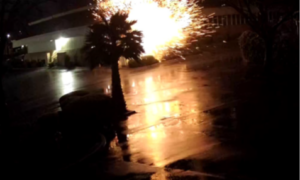Reservations open starting Nov. 18 for visitors who want to catch sight of the natural firefall in Yosemite National Park as Horsetail Fall glows orange during sunsets in February.
Park officials announced the opening of day-use reservations starting 8 a.m. Monday. Fifty percent of the park’s daily day-use reservations will be reserved for those who want to witness the firefall event.
The reservations will be required to drive into the park 24-hours a day for the three weekends in February—Feb. 8-9, Feb. 15-17, and Feb. 22-23.
“During February, thousands of visitors visit Horsetail Fall, a waterfall that can glow orange when it’s backlit by sunset, which can make it appear to be on fire,” park officials said on social media Wednesday.
The unique lighting effect happens only on evenings with a clear sky when water is flowing down the waterfall, and when the sun is at the right angle, which only happens in mid- to late February, according to park officials.
The park has implemented a similar reservation system for the event over the past few years.
Years ago, Yosemite National Park rangers created their own firefall by pushing campfire embers off the nearby Glacier Point. Originally started by James McCauley in 1873, the Irishman would entertain hotel guests at his Mountain House hotel at Glacier Point by building a large campfire and telling tales.
As the night wound down, they pushed the embers over the cliff. The “firefall” drew spectators each night. The firefall ran until 1897, when the hotel changed hands, but started up again two years later, according to the park.
Curry Village, with its wood-framed tent cabins at the eastern end of Yosemite Valley, became a popular spot to view the firefall during the summer.
The campfire became an outdoor stage with ranger talks and musicians for entertainment, and the firefall as its program finale.
Former school principal and teacher in the 1960s Jack McLaughlin and his wife Sheryl McLaughlin remembered standing on Stoneman Bridge every night during the summer as newlyweds. A ranger would call down to another ranger on the valley floor and yell “are you ready?” and the ranger below would answer.
“They would yell back, ‘let the fire fall!” Sheryl McLaughlin told The Epoch Times. “It was beautiful. It lasted a couple of minutes.”
The campfires and manmade firefall ended in the winter of 1968 when ordered by the National Park Service. The number of visitors attempting to see the firefall was increasing car traffic that damaged meadows. The threat of a fire was also a concern, according to the park.

President Theodore Roosevelt (L) poses with naturalist and botanist John Muir on Glacier Point in Yosemite, California. The original Yosemite National Park firefall started here in 1873. (MPI/Getty Images)
The natural firefall event now also attracts many visitors to the small area, causing traffic congestion, parking issues, safety concerns, and impacts to natural and cultural resources, the park says.
“A memo came around the school that said, ‘tonight will be the last one ever,’” Jack McLaughlin said.
The natural firefall at Horsetail Fall was discovered in February 1973 and continues to draw visitors who want to see the spectacular event, according to the park.
Park officials came up with the reservation system to manage the event.
Day-use reservations will also be required for visitors who want to see the park, even if they are not visiting Horsetail Fall.
Visitors who arrive Mondays through Fridays, except on Feb. 17, won’t need a reservation.
The entrance fee is $35 per car and is valid for seven days, regardless of the day of arrival.

Water flowing off Horsetail Fall glows orange while backlit from the setting sun during the "Firefall" phenomenon in Yosemite National Park, California, on Feb. 15, 2023. (Frederic J. Brown/AFP via Getty Images)
Those who have a lodging reservation for Yosemite Valley, Wawona, Foresta, or Yosemite West don’t need an additional entrance reservation.
Campground reservations will also be required for Camp 4, Hodgdon Meadow, and Wawona campgrounds from Feb. 8 through Feb. 23, according to the park.
The campgrounds are typically operated on a first-come, first-served basis in February. Campground reservations will be available starting at 7 a.m. Dec. 15 at recreation.gov.














